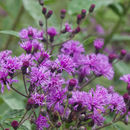Description
provided by eFloras
Plants 8–20(–30+) dm. Stems puberulent, glabrescent. Leaves mostly cauline; blades ± lanceolate, 12–25+ cm × 20–60+ mm, l/w = (3.5–)4–7+, abaxially scabrellous (hairs awl-shaped), sometimes glabrescent, not or sparsely resin-gland-dotted, adaxially strigillose, glabrescent, not resin-gland-dotted. Heads in corymbiform-scorpioid arrays. Peduncles 1–12(–20+) mm. Involucres broadly campanulate to hemispheric, 4–5+ × 4–5 mm. Phyllaries 30–40+ in 4–5 series, glabrate, margins ciliolate, the outer lance-ovate, 1–2 mm, inner oblong, 3.5–5 mm, tips acute or rounded-apiculate. Florets (9–)18–24(–30). Cypselae 2.5–3.5 mm; pappi usually purplish, sometimes stramineous, outer scales 20–25, 0.5–1 mm, contrasting with 35–40+, 4.5–6+ mm inner bristles. 2n = 34.
- license
- cc-by-nc-sa-3.0
- copyright
- Missouri Botanical Garden, 4344 Shaw Boulevard, St. Louis, MO, 63110 USA
Synonym
provided by eFloras
Chrysocoma gigantea Walter, Fl. Carol., 196. 1788; Vernonia altissima Nuttall; V. altissima var. taeniotricha S. F. Blake; V. gigantea subsp. ovalifolia (Torrey & A. Gray) Urbatsch; V. ovalifolia Torrey & A. Gray
- license
- cc-by-nc-sa-3.0
- copyright
- Missouri Botanical Garden, 4344 Shaw Boulevard, St. Louis, MO, 63110 USA
Comprehensive Description
provided by North American Flora
Vernonia ovalifolia T. & G. Fl. N. Am. 2: 59. 1841
Vernonia noveboracensis latifolia A. Gray, Syn. Fl. N. Am. I 2 : 89, in part. 1884. Vernonia ovalifolia purpurea Gleason, Bull. Torrey Club 46: 24S. 1919.
Stems erect, simple or sparingly branched, 8-12 dm. high, glabrous or puberulent; leafblades variable in size and shape, typically elliptic-oblong to lance-ovate, 8-10 cm. long, 2-5 cm. wide, acute or short-acuminate, coarsely serrate, or entire toward the acute to obtuse or rounded base, smooth or scabrous above, glabrous, pale and glaucescent, or puberulent on the veins beneath, short-petioled or sessile; inflorescence flattened, loose; heads 18-21 -flowered; involucre broadly campanulate, 5-6 mm. high; scales rather regularly imbricate, glabrous or minutely puberulent, ciliate, appressed at base, somewhat spreading at the carinately thickened, short-acuminate, cuspidate apex; achenes pubescent on the ribs, glabrous or sparsely resinous in the furrows, 3 mm. long; pappus tawny or rarely purple, the bristles 6 mm. long, the scales linear to oblong, 0.6-0.8 mm. long.
Type LOCALITY: Middle Florida. Distribution: Georgia, Florida, and Alabama.
- bibliographic citation
- Per Axel, Rydberg. 1922. CARDUALES; AMBROSIACEAE, CARDUACEAE. North American flora. vol 33(1). New York Botanical Garden, New York, NY
Comprehensive Description
provided by North American Flora
Vernonia gigantea (Walt.) Trel.; Brann. & Coy Rep. Geol. Surv. Ark. 1888 4 : 189. 1891.
Chrysocoma gigantea Walt. Fl. Car. 196. 1788.
Vernonia altissima Less. Linnaea 6: 639, in part. 1831. Not V. altissima Nutt. 1S18.
Vernonia ovalifolia T. & G. Fl. N. Am. 2: 59, in part. 1841.
Vernonia altissima parviflora A. Gray, Syn. Fl. N. Am. I 2 : 90. 1S84.
Cacalia gigantea Kuntze, Rev. Gen. 324. 1891.
Vernonia oligantha Greene, Pittonia 5: 56. 1902.
Vernonia gigantea praealta Daniels, Univ. Missouri Stud. Sci. 1: 402. 1907.
Stems erect, branched above, 5-20 dm. high, glabrous or nearly so; leaf-blades thin, bright-green, lanceolate to elliptic or elliptic-oblong, 8-20 cm. long, 1-7 cm. wide, acute to acuminate, sharply serrate or the upper nearly entire, narrowed to an acute or acuminate base, glabrous, minutely puberulent, or scabrellate at the margin, minutely puberulent and resinous beneath; petioles 5-20 mm. long; inflorescence flattened, loose, irregular, 5-40 cm. broad; heads 8-1 3-flowered; involucre obpyramidal, 3-4 mm. high; scales loosely and irregularly imbricate in few series, oblong to oblong-ovate, obtuse and rounded to sharply acute, glabrous or puberulent, frequently ciliate; achenes thinly pubescent on the ridges, resinous in the furrows, 3-3.5 mm. long; pappus dull-purple, the bristles 5-6 mm. long, the scales narrow, 0.6-0.7 mm. long.
Type locality: South Carolina.
Distribution: South Carolina, Georgia, and Florida.
- bibliographic citation
- Per Axel, Rydberg. 1922. CARDUALES; AMBROSIACEAE, CARDUACEAE. North American flora. vol 33(1). New York Botanical Garden, New York, NY
Vernonia gigantea
provided by wikipedia EN
Vernonia gigantea (also known as giant ironweed,[1] tall ironweed[2] or ironweed[3]) is a species of perennial plant from family Asteraceae found in United States and Canada.[1] The plant is native to the eastern United States, north to New York state and Ontario, and southwest to Texas.[1]
Description

Tall Ironweed
(Vernonia gigantea)
They are described as 0.9–2.1 metres (3–7 ft) tall,[4] or 1.5 m–3.0 m × 0.3 m–0.6 m (5 ft–10 ft × 1 ft–2 ft).[3] The stem is either green or purplish green coloured, and can be either hairy or pubescent. The leaves are up to 250 mm (10 in) long and 50 mm (2 in) across, and are ovate. Their leaves could also be lanceolate-oblong or elliptically shaped, with serrated margins. The leaves' upper surface is hairless and is dark green in colour. The leaves' bases may have a petiole or be sessile.[4] The flowers open from July to September and are purple in colour. They can be found growing in moist soils along roadsides, and are common in meadows and open woodlands.[3]
The seeds are wind-dispersed. The plant is self-incompatible and exhibits substantial ecotypic variation, a factor which may explain their broad geographic distribution.[5]
Ecology
V. gigantea is a larval host to the ironweed borer moth (Papaipema cerussata) and the red groundling moth (Perigea xanthioides).[6]
References

- license
- cc-by-sa-3.0
- copyright
- Wikipedia authors and editors
Vernonia gigantea: Brief Summary
provided by wikipedia EN
Vernonia gigantea (also known as giant ironweed, tall ironweed or ironweed) is a species of perennial plant from family Asteraceae found in United States and Canada. The plant is native to the eastern United States, north to New York state and Ontario, and southwest to Texas.
- license
- cc-by-sa-3.0
- copyright
- Wikipedia authors and editors

